Creative production
How to store and edit large video files: the complete guide
August 2025
8 mins

Table of contents
Your files, faster.
Access any file instantly, anywhere. Collaborate in real-time from one always-up-to-date, secure cloud filespace.
If you’ve ever watched Premiere crawl through a 6K timeline, or run out of drive space mid-project, you know the pain of editing large video files all too well.
Add deadlines into the mix, and it’s enough to send any creative over the edge.
But large video files are the new reality. More footage, higher resolutions and complex codecs mean hundreds of gigs have now ballooned into terabytes.
This makes knowing how to store large video files and how to edit large video files without sacrificing speed or quality is essential. Here are our top tips to keep your projects moving and your creativity flowing.
The frustrations of working with large video files
As a video editor, you’re tasked with delivering creatively compelling projects and managing the technical side of your craft too. And that’s only getting harder.
Modern video editing workflows create a perfect storm of complications:
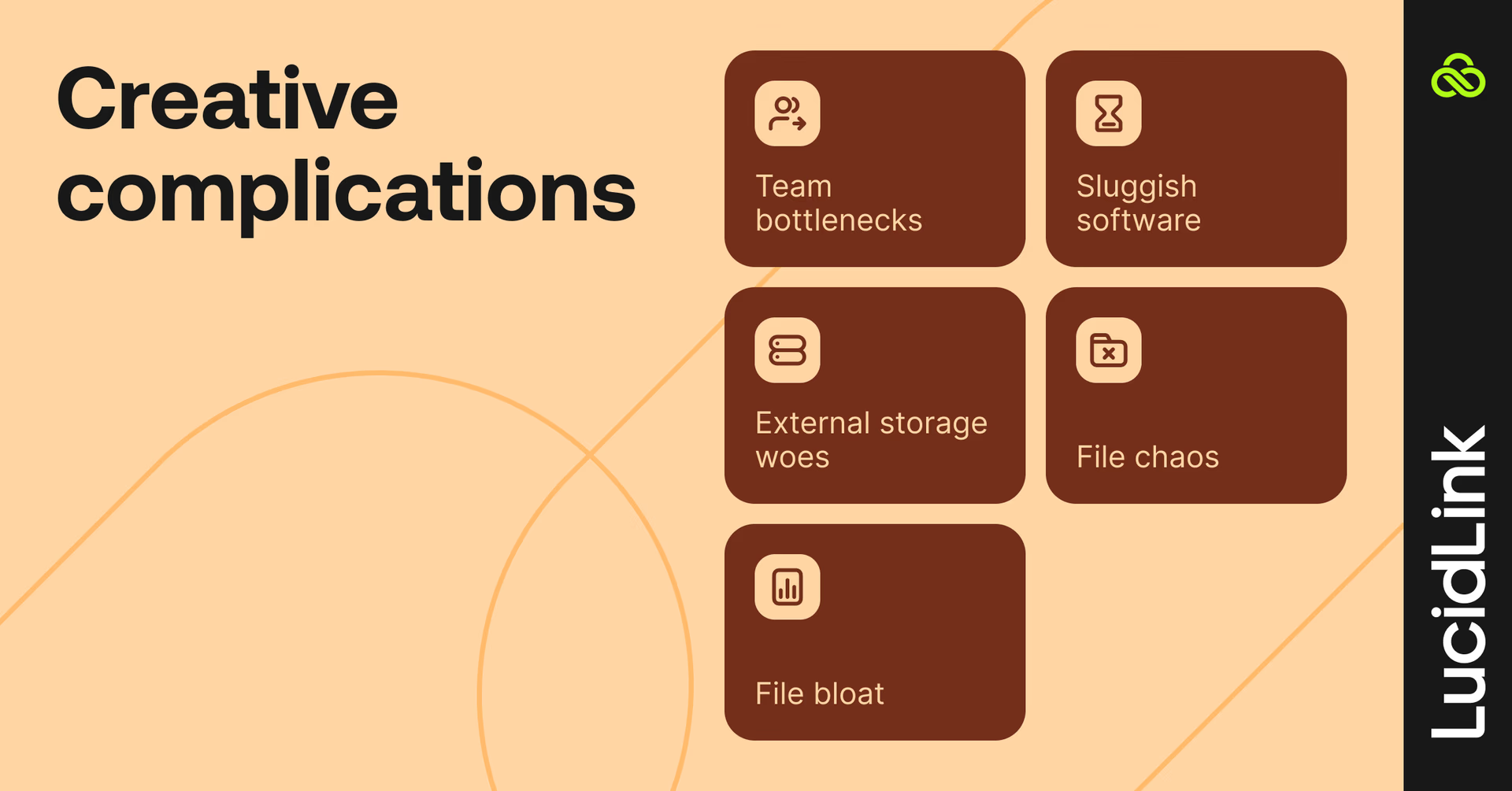
File bloat: massive files eat up premium storage space fast
Sluggish software: laggy timelines, dropped frames, endless export times
Team bottlenecks: waiting on downloads, uploads or approvals
File chaos: missing assets, version conflicts, sync errors
External storage woes: more drives in fewer ports, overheated SSDs, limited access
All these workflow roadblocks eat into your productivity — wasting time, money and sapping creative energy.
How to store large video files: best storage options
So, what’s the best way to store large video files and keep playback smooth while editing?
First up, your computer needs enough processing muscle power to handle the format, resolution and codec you’re editing. You’ll need a beefier machine to handle 6K RED RAW files than HD H.264 movs, because the files are far more complex to process.
Luckily, Apple Silicon M series Macs come with built-in video processing chips, and newer Windows machines are catching up too.
But even the best system needs fast storage to keep up. If your drives can’t deliver data fast enough, your playback will still stutter.
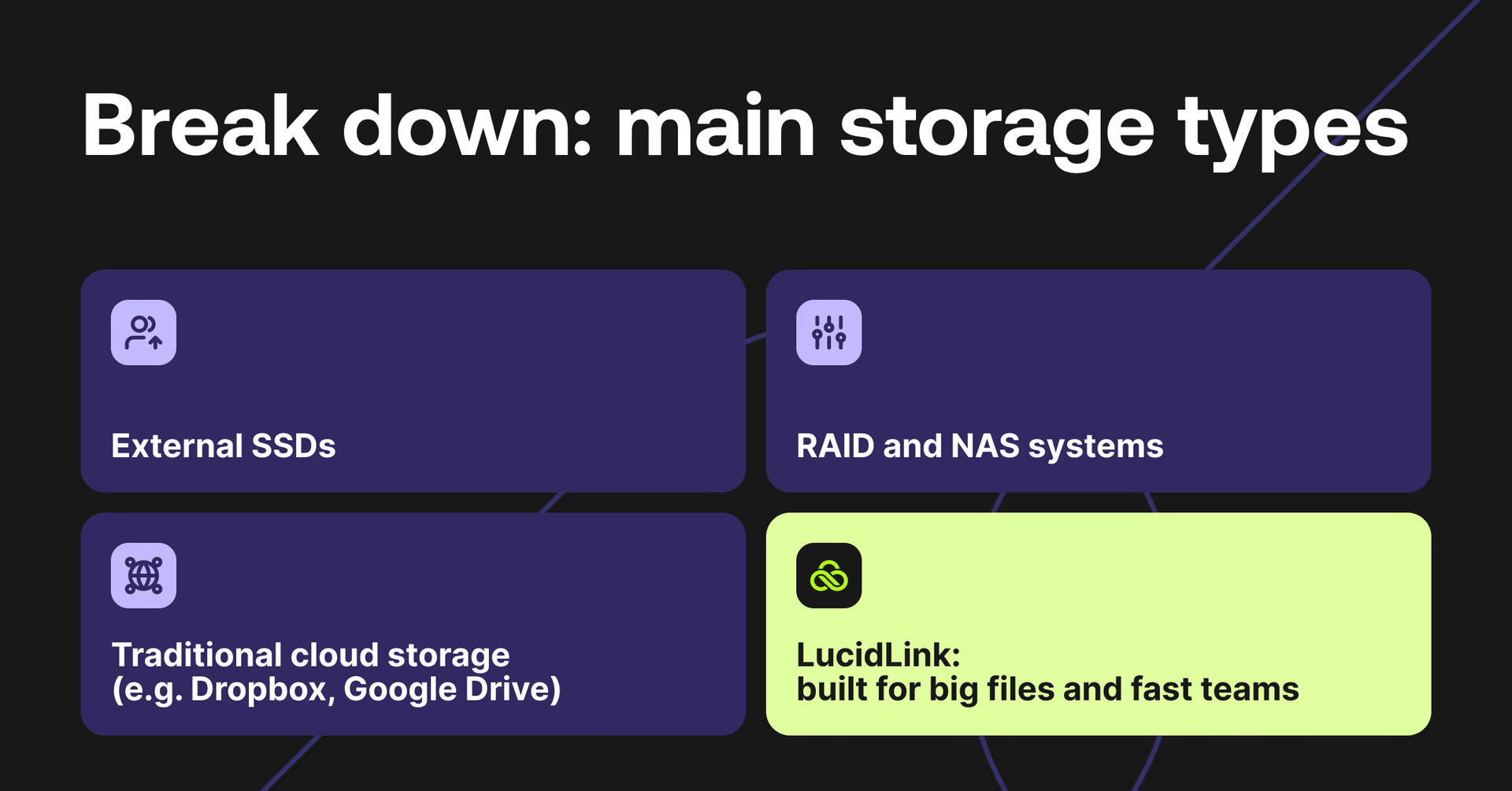
External SSDs: fast but limited
External SSD (Solid State Drives) are popular for solo editors working on small-medium sized projects. They’re affordable, portable and deliver fast playback performance. But there’s a trade-off: limited capacity.
While you can get 8TB SSDs, a general rule of thumb is that the larger the SSD capacity the slower the performance. This means larger video editing projects will need to be split across multiple SSD drives.
You’ll also need a way to back them up securely and efficiently.
SSDs are good for on-location editing and offloading footage from camera cards, thanks to their compact size and lack of moving parts. But this does also make them vulnerable to loss or theft.
One more thing: SSD performance tends to dip once drives are around 70–80% full. They can also slow down as they age and accumulate heavy use.
RAID and NAS systems: powerful but complex
For editors managing massive projects — or entire teams — RAID and NAS systems are popular choices for storing large video files. You’ll often find them in post-production houses and professional edit suites.
These systems combine multiple drives into one storage pool, improving speed and adding built-in redundancy. If a single drive fails, your data stays safe because pieces of it are duplicated across other drives.
But there’s a catch: complexity. Bigger setups mean more maintenance and more IT know-how. Large studios may have tech support, but for freelancers, managing a RAID or NAS can be a lot to take on.
You can edit remotely from a NAS or RAID system, but it’s not always smooth sailing:
NAS/RAID needs to be switched on all the time
Syncing between local and remote storage isn’t automatic
Performance depends on the number of users and how large the video files are
Internet bandwidth is a real bottleneck
RAID and NAS solutions are powerful — but if you’re looking for a simpler way to store and edit large video files, cloud-native options can save you serious time and hassle.
Traditional cloud storage: convenient, but not built for video
Tools like Dropbox, Google Drive and others make it easy to back up files and share documents. But when it comes to storing large video files or editing large video files, these platforms start to show their limits.
The main issue? Before you can edit anything, you have to download the entire video file to your local drive. That means you still need enough local storage to handle those huge files — not to mention plenty of patience while you wait.
Because files have to be downloaded and shared manually, it’s easy for version control issues to creep in — leading to duplicate files, confusion over which edit is current and wasted time on rework.
All of which eats up valuable creative time managing file syncing and sharing.
LucidLink: built for large video files and fast collaboration
That’s why many editors are turning to cloud-native solutions built specifically for video editing with large files. This is where LucidLink changes the game.
Instead of forcing you to choose between local speed and cloud flexibility, it gives you both. It’s purpose-built for the demands of cloud video editing workflows, no matter the resolution, format or codec.
LucidLink lets you:
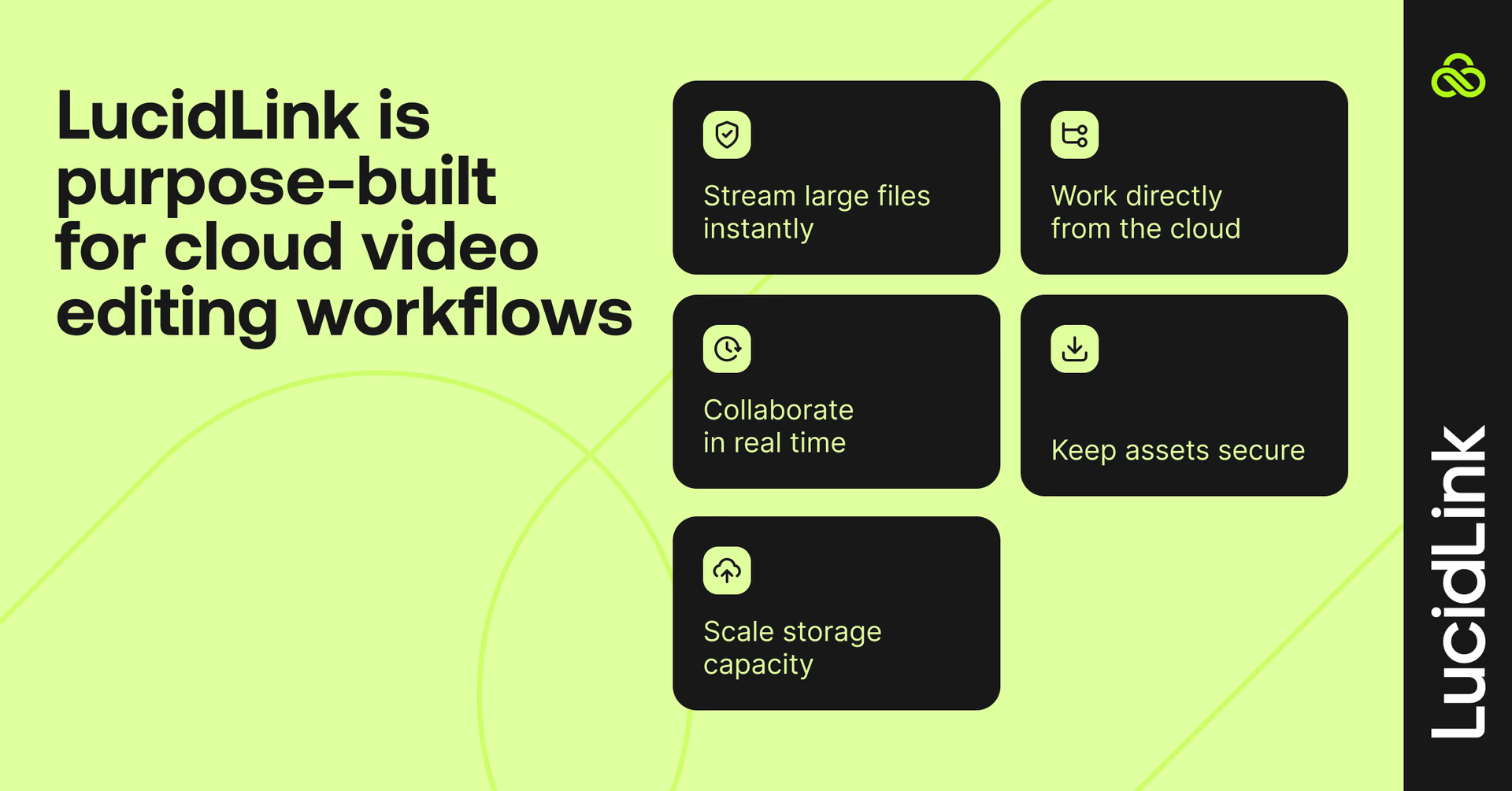
Stream large files instantly, so there are no downloads to wait for
Work directly from the cloud like it’s a local drive
Collaborate in real time with global team members
Keep assets secure with zero-knowledge encryption as standard
Scale storage capacity effortlessly without buying more hardware
LucidLink’s platform is sophisticated enough to underpin production of the award-winning TV series like The Bear, but simple enough to get started right away. It’s a smarter way to store and edit large video files — without sacrificing speed, quality or creative flow.
How to store large video files: storage tips
When it comes to best practices for storing large video files, a few simple steps can dramatically improve both playback performance and collaboration.
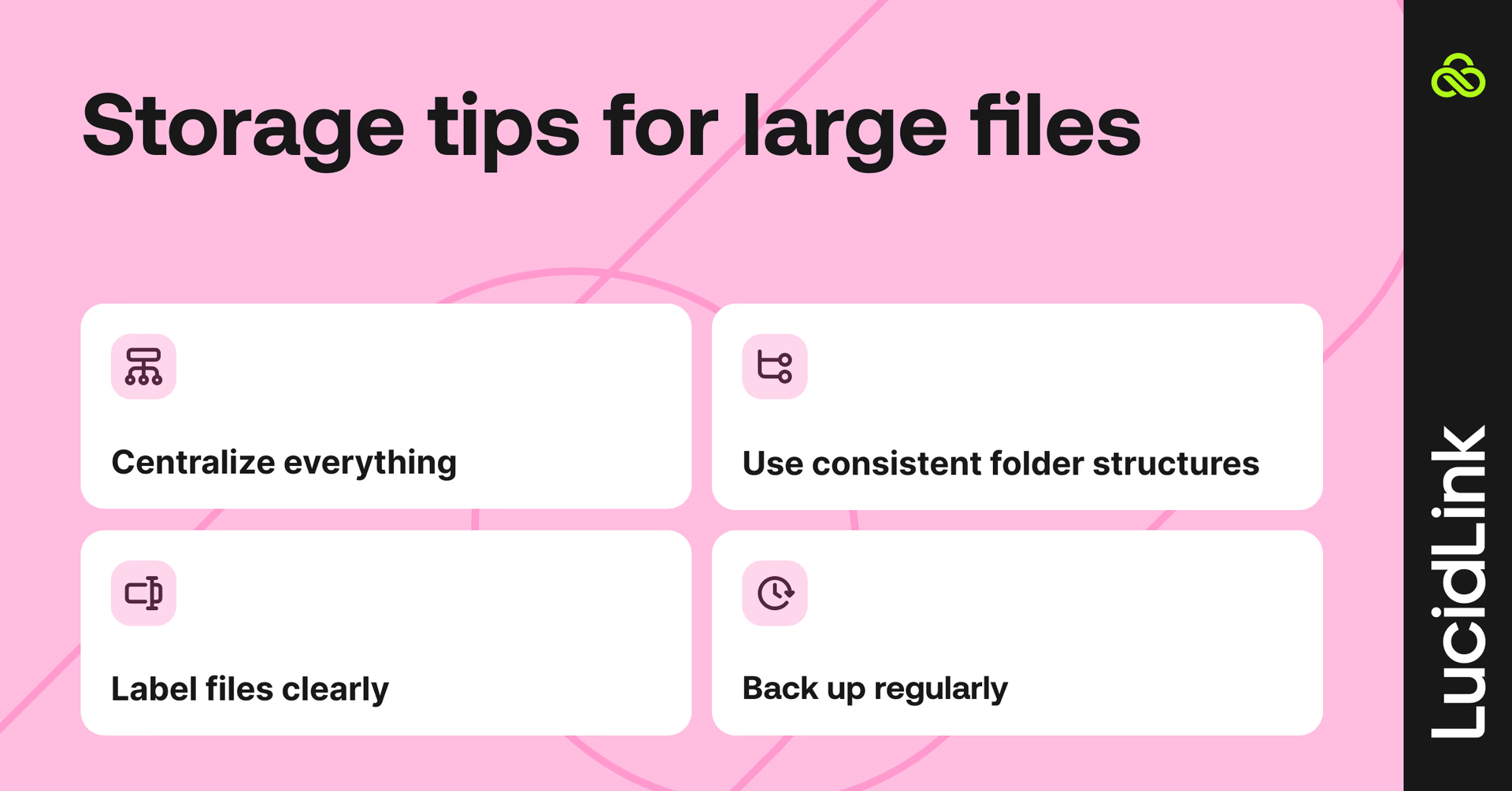
Centralize everything
Keep all your assets in one central location that can be easily accessed both locally and remotely. This is easier to manage and maintain on an ongoing basis, from both a hardware and capacity perspective.
Avoid scattering files across drives or platforms to protect against data loss, wasted time searching and added expense.
Use consistent folder structures
Using a logical, consistent and concise folder structure to make it easy for teammates to find what they need.
If every video production project uses the same general folder structure it will be intuitively easier for everyone to store files where other people will expect to find them.
Avoid making the folder structure too dense as this leads to too many clicks each time.
Label files clearly
Similarly, using a naming convention that tells you what is in each file saves a lot of time narrowing down, finding and looking inside each piece of media.
For example, use a naming convention that includes project name, date, version number, revision status and essential notes.
LucidLink_200525_Trailer_v1_Ungraded_For Review.mov
Back up regularly
Stick to the 3-2-1 rule: 3 copies, 2 locations, 1 off-site. Always automate backups where possible to save time and ensure consistent protection.
As part of this always, incrementally save your projects and archive previous versions so that you can revert to earlier approaches if the client suddenly changes their mind.
How to edit large video files: expert tips
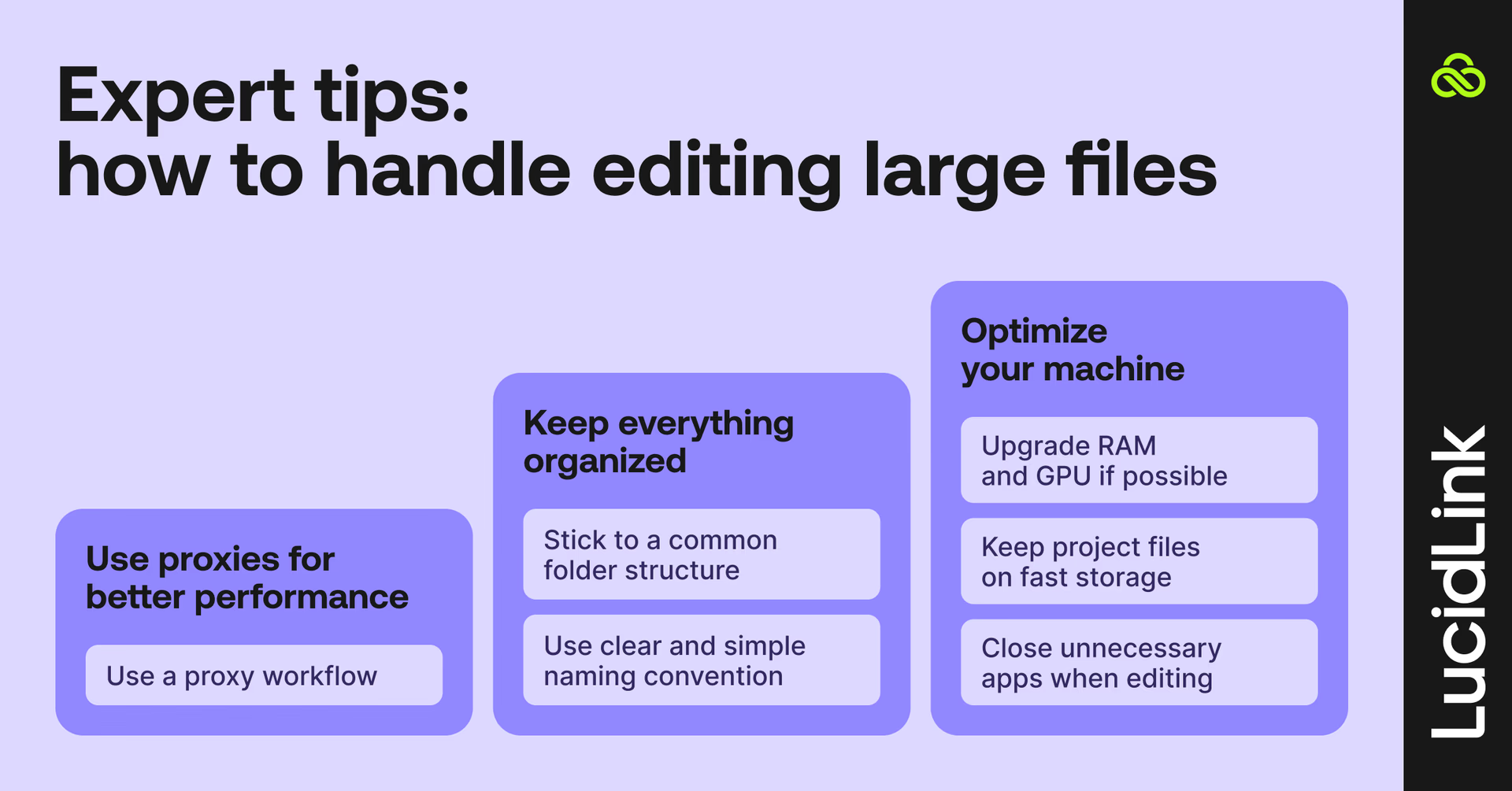
Editing large video files starts with a computer powerful enough to handle the formats, resolutions and codecs you’re working with.
The next foundation is fast storage that can deliver media to your editing software without slowing you down.
But even once you have great tech and tools, there are smart techniques you can use to keep your workflow smooth and avoid frustrating lags.
Optimize your machine
The best video editing computers will have as much RAM and the strongest GPUs you can afford, plus dedicated video processing chips like Apple silicon’s Media Engine.
This power chews through complex codecs, large resolutions and computing all those star wipes and video effects you must have.
Upgrade RAM and GPU if possible
Choose a machine with dedicated video encoders/decoders
Keep project files on fast storage (SSD or LucidLink filespace)
Close unnecessary apps when editing
Keep software and OS up to date
Don’t overfill your hard drives
Use proxies for smoother performance
A handy trick for better playback from a weaker machine or slower hard drive is to use a proxy workflow.
Proxies are lower quality, smaller file size versions of your media that are easier for the computer to playback and share. But they contain the same timecode and metadata, so you can seamlessly toggle back to full-quality media for final export.
Proxies can easily be created in:
Adobe Premiere Pro
DaVinci Resolve
Final Cut Pro
Avid Media Composer
Edit Ready
Some production cameras
Curious to know how you can send video without losing quality? We’ve got a guide for that.
Keep everything organized
While it might sound less exciting than buying a shiny new Mac, good data management will deliver better returns than the latest chips when it comes to saving time.
Here’s a recap of best practices for storing and editing large video files:
Stick to a common folder structure
Use clear and simple naming convention
Ensure version control with incremental numbering
Centralize storage so teams aren’t needlessly duplicating files
Use LucidLink for collaborative synchronous video editing
Why LucidLink is the future of working with large video files
If storing and editing large video files isn’t a daily challenge for your workflow, it probably will be soon. Video resolutions keep climbing — and so do file sizes.
But those big files come with major benefits: sharper visuals, more creative flexibility and space to perfect your craft.
LucidLink lets you get all the benefits of large video files, without the frustrating admin and wasted time.
Store your large video files in LucidLink and you’ll get:
Real-time access to huge video files in an instant
Time back not waiting for downloads
Instant updates for everyone (and no more version confusion)
Unlimited and flexible cloud storage capacity
Secure, centralized, cloud-native collaborative workflows
Try LucidLink free for 30 days and discover a better way to store, access and edit large video files — without slowing your team down.
Or, see how Sandwich, the de facto creative studio for Silicon Valley, creates standout campaigns for top tech brands with a video workflow powered by LucidLink here.
FAQs
For large video files, use fast SSDs for local speed or RAID/NAS for bigger storage. But for the best of both worlds, cloud solutions like LucidLink let you store huge video files and work on them instantly, without downloads, keeping workflows fast and collaborative.
An SSD is faster and more reliable for editing large video files, ensuring smooth playback and quick access. Hard drives (HDDs) are cheaper but too slow for real-time editing. Use SSDs for active projects and HDDs for long-term storage or archives.
Yes. Unlike traditional cloud storage, LucidLink lets you store and edit large video files directly from the cloud. Files stream instantly without downloads, so you can edit huge footage in real-time, ideal for collaborative video teams working across different locations.
Edit large video files smoothly by using fast SSD storage or LucidLink’s cloud streaming, upgrading RAM and GPU, and working with proxy files for lighter editing. Keep drives under 80% full and close background apps to prevent slowdowns and dropped frames.
A powerful computer helps when editing large video files, especially for high resolutions or complex effects. But you can manage with modest hardware using proxies and fast cloud solutions like LucidLink, which stream large files without overloading local drives.
The best remote video editing workflow uses cloud tools like LucidLink, which stream large files instantly and eliminate downloads. Teams work from the same cloud drive, reducing version issues and keeping projects in sync, even with huge video files across locations.
Keep reading
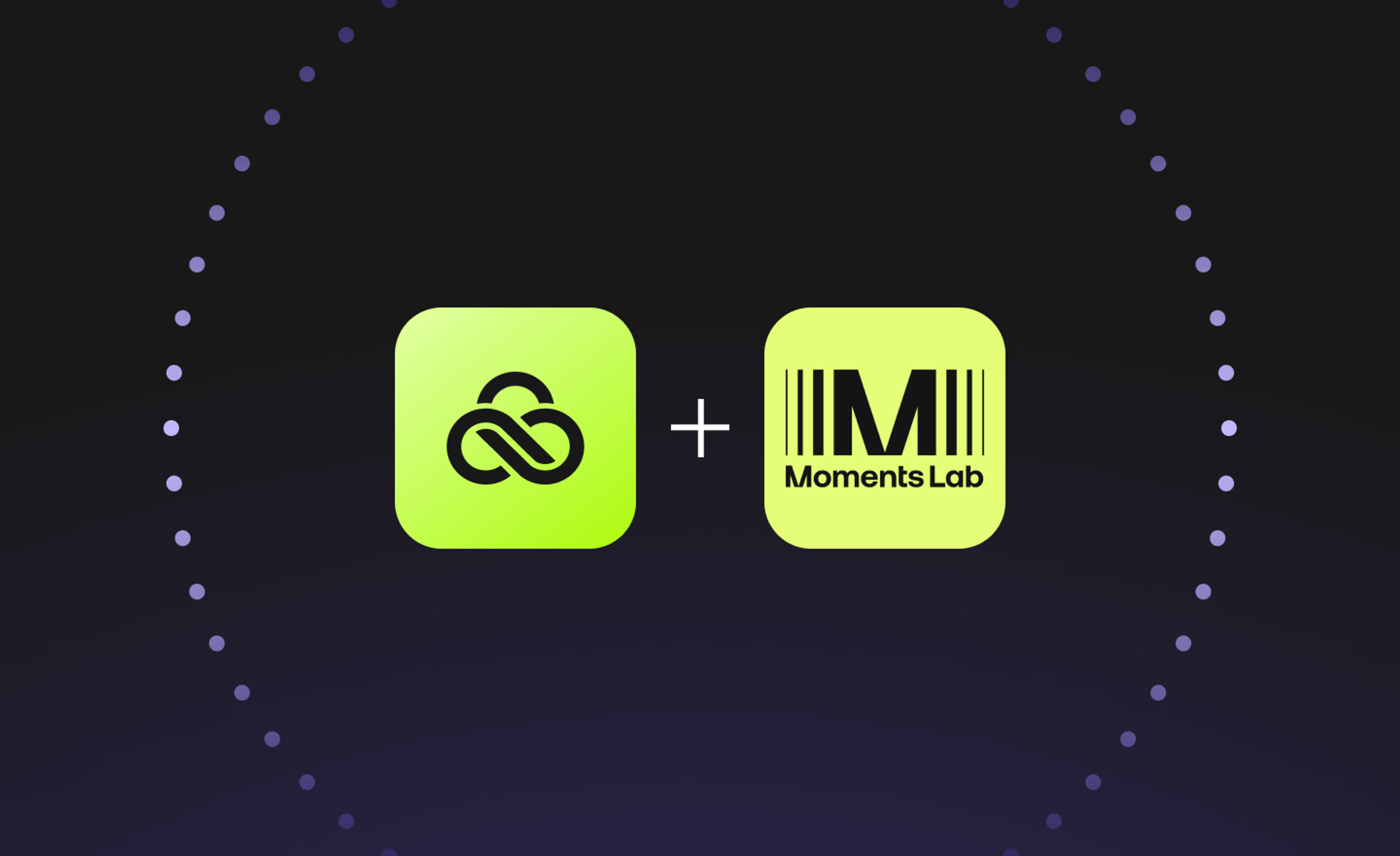
Creative production
Unlocking the potential of your media library with AI and real-time access
Explore how AI and real-time access make your media library searchable, actionable and ready for faster, smarter storytelling.
16 December 2025, 5 mins read

Creative production
How to build a creative workflow that really flows
Discover how to build a seamless creative workflow using practical strategies and tools. Get tips for collaboration and creative project management.
26 November 2025, 17 mins read

Creative production
Sports video editing: the complete guide for sports highlights and video editing
Learn how to create pro-level sports highlight videos with the best sports video editing software. Tips, tools and real-world workflows included.
20 November 2025, 7 mins read
Join our newsletter
Get all our latest news and creative tips
Want the details? Read our Privacy Policy. Not loving our emails?
Unsubscribe anytime or drop us a note at support@lucidlink.com.